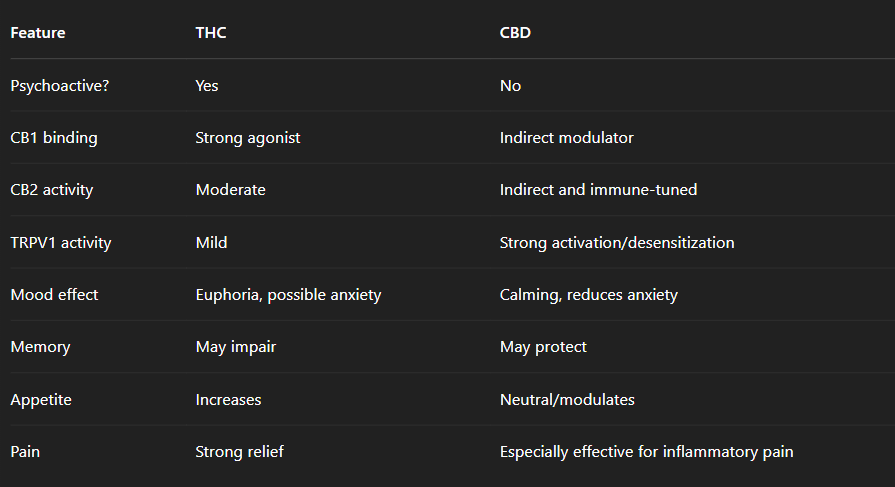The cannabis plant contains powerful compounds called phytocannabinoids, which interact with the body’s endocannabinoid system (ECS) — a critical network that regulates mood, pain, sleep, immune response, and metabolism.
Two of the most well-known phytocannabinoids are THC (tetrahydrocannabinol) and CBD (cannabidiol). While both influence the ECS, they do so in very different ways, leading to distinct effects on the brain and body.
In this article, we explore the differences between THC and CBD, how they impact CB1 receptors, and how they support the ECS and related systems like TRPV1.
🧬 What Are Phytocannabinoids?
Phytocannabinoids are cannabinoid compounds derived from plants, primarily Cannabis sativa. They are structurally similar to the body’s own endocannabinoids, like anandamide (AEA) and 2-AG, which is why they can interact with:
- CB1 receptors – mostly in the brain and central nervous system
- CB2 receptors – mostly in the immune system and gut
- TRPV1 receptors – involved in pain, inflammation, and heat perception
🌿 THC: Binds Directly to CB1
THC binds directly to CB1 receptors like a key fitting into a lock. This strong activation causes the psychoactive "high" associated with cannabis use.
🔍 Key Effects of THC:
- Euphoria
- Relaxation
- Increased appetite
- Altered sensory perception
- Pain relief
- Short-term memory impairment
- In some cases, anxiety or paranoia
✅ THC is clinically useful for:
- Chronic pain (especially nerve-related)
- Muscle spasms (e.g. in MS)
- Appetite stimulation (e.g. in cancer or HIV)
- Nausea (e.g. from chemotherapy)
- Sleep disorders
🌿 CBD: A Modulator, Not an Activator
In contrast, CBD does not bind strongly to CB1 receptors. Instead, it binds indirectly and changes the shape of the receptor, preventing THC from binding as tightly. This phenomenon is called negative allosteric modulation.
🔄 CBD’s Role:
- Reduces THC’s psychoactive effects
- Decreases THC-induced anxiety
- Improves short-term memory retention
- Promotes balance without euphoria
✅ CBD is widely used for:
- Anxiety and mood regulation
- Inflammation (gut, brain, joints)
- Epilepsy and neuroprotection
- Pain modulation
- Support for immune and gut function
🧠 The image you shared perfectly illustrates this:
- On the left, THC alone binds to CB1, triggering euphoria and potential memory effects.
- On the right, CBD partially blocks THC’s access to the receptor, softening its impact.
🔥 What About TRPV1?
Both CBD and anandamide (an endocannabinoid) activate TRPV1, a receptor involved in:
- Pain and heat sensitivity
- Inflammation regulation
- Gut-brain communication
- Emotional processing
CBD’s modulation of TRPV1 is one reason it’s helpful in conditions like chronic pain, IBS, migraines, and stress-related hypersensitivity.
🧠 THC vs. CBD at a Glance

🌿 The Entourage Effect
CBD and THC work best together in balanced formulas. Their synergy — called the entourage effect — is why full-spectrum cannabis extracts often outperform isolates.
- CBD reduces THC-related side effects
- THC boosts pain relief
- Terpenes and minor cannabinoids (like CBG, CBC) enhance therapeutic actions
✅ How to Support Your ECS with Phytocannabinoids

Always start low and go slow, especially with THC. Everyone’s ECS tone and sensitivity are different.
🌱 Final Thoughts
Phytocannabinoids like THC and CBD offer powerful ways to influence your body’s own regulatory systems. While THC binds directly to CB1 receptors to trigger euphoria and pain relief, CBD acts as a smart modulator, buffering the effects of THC and interacting with other systems like TRPV1 to reduce pain and inflammation.
By understanding how these molecules interact — especially at CB1 receptors as shown in the visual — you can better tailor your use of cannabis-based therapies to meet your unique needs.
👉 Not sure which DNA test is best for you? Click here to book your free 15-minute intake call now!

